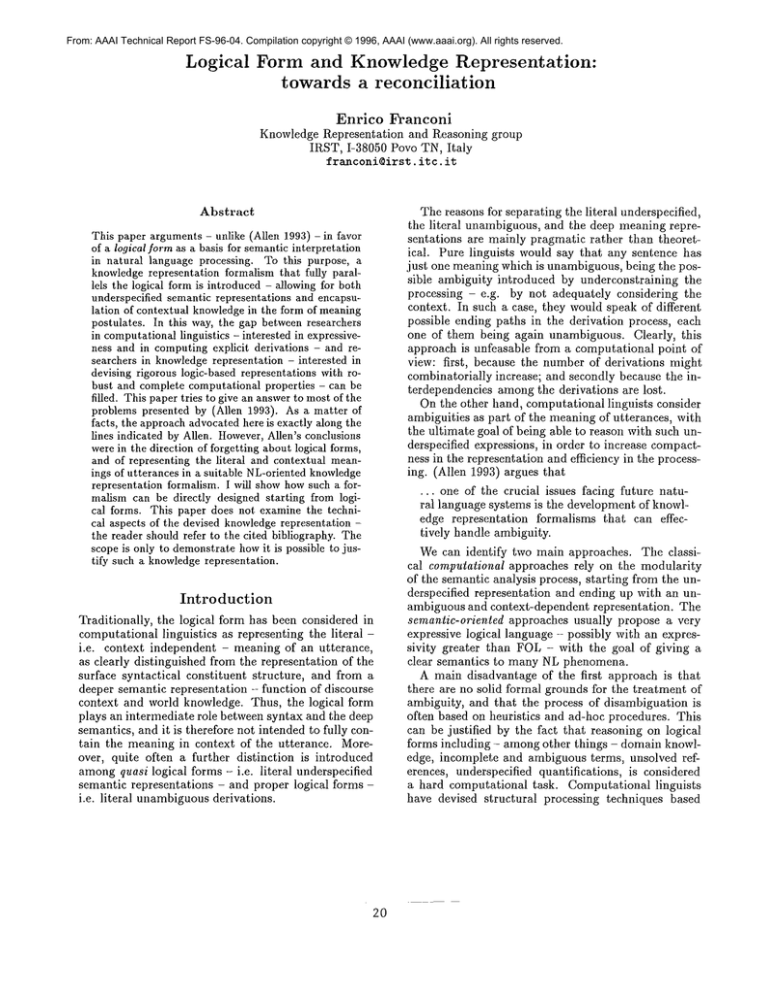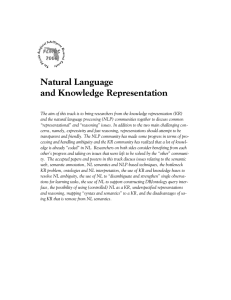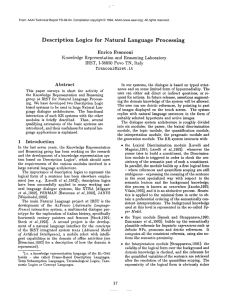
From: AAAI Technical Report FS-96-04. Compilation copyright © 1996, AAAI (www.aaai.org). All rights reserved.
Logical
Form and Knowledge Representation:
towards a reconciliation
Enrico
Franconi
Knowledge Representation and Reasoning group
IRST, 1-38050 Povo TN, Italy
franconi@irst,
i~c.it
Abstract
This paper arguments- unlike (Allen 1993) - in favor
of a logical ]orrn as a basis for semanticinterpretation
in natural language processing. To this purpose, a
knowledgerepresentation formalismthat fully paxallels the logical form is introduced - allowing for both
underspecified semantic representations and encapsulation of contextual knowledgein the form of meaning
postulates. In this way, the gap betweenresearchers
in computationallinguistics - interested in expressiveness and in computingexplicit derivations - and researchers in knowledgerepresentation - interested in
devising rigorous logic-based representations with robust and complete computational properties - can be
filled. This paper tries to give an answerto mostof the
problems presented by (Allen 1993). As a matter
facts, the approachadvocatedhere is exactly along the
lines indicated by Allen. However,Allen’s conclusions
werein the direction of forgetting about logical forms,
and of representing the literal and contextual meanings of utterances in a suitable NL-orientedknowledge
representation formalism. I will showhowsuch a forrealism can be directly designed starting from logical forms. This paper does not examinethe technical aspects of the devised knowledgerepresentation the reader should refer to the cited bibliography. The
scope is only to demonstratehowit is possible to justify such a knowledgerepresentation.
Introduction
Traditionally, the logical form has been considered in
computational linguistics as representing the literal i.e. context independent - meaning of an utterance,
as clearly distinguished from the representation of the
surface syntactical constituent structure, and from a
deeper semantic representation -- function of discourse
context and world knowledge. Thus, the logical form
plays an intermediate role between syntax and the deep
semantics, and it is therefore not intended to fully contain the meaning in context of the utterance. Moreover, quite often a further distinction is introduced
amongquasi logical forms - i.e. literal underspecified
semantic representations - and proper logical forms i.e. literal unambiguousderivations.
20
The reasons for separating the literal underspecified,
the literal unambiguous, and the deep meaning representations are mainly pragmatic rather than theoretical. Pure linguists would say that any sentence has
just one meaning which is unambiguous, being the possible ambiguity introduced by underconstraining the
processing - e.g. by not adequately considering the
context. In such a case, they would speak of different
possible ending paths in the derivation process, each
one of them being again unambiguous. Clearly, this
approach is unfeasable from a computational point of
view: first, because the number of derivations might
combinatorially increase; and secondly because the interdependencies amongthe derivations are lost.
On the other hand, computational linguists consider
ambiguities as part of the meaning of utterances, with
the ultimate goal of being able to reason with such underspecified expressions, in order to increase compactness in the representation and efficiency in the processing. (Allen 1993) argues that
... one of the crucial issues facing future natural language systems is the development of knowledge representation formalisms that can effectively handle ambiguity.
Wecan identify two main approaches. The classical computational approaches rely on the modularity
of the semantic analysis process, starting from the underspecified representation and ending up with an unambiguous and context-dependent representation. The
semantic-oriented approaches usually propose a very
expressive logical language - possibly with an expressivity greater than FOL- with the goal of giving a
clear semantics to many NL phenomena.
A main disadvantage of the first approach is that
there are no solid formal grounds for the treatment of
ambiguity, and that the process of disambiguation is
often based on heuristics and ad-hoc procedures. This
can be justified by the fact that reasoning on logical
forms including - amongother things - domain knowledge, incomplete and ambiguous terms, unsolved references, underspecified quantifications, is considered
a hard computationM task. Computational linguists
have devised structural processing techniques based
structured information such as frames - carefully trying to avoid or to drastically reduce the inclusion in the
computational machinery of logical inferencing mechanisms for treating ambiguities. Of course, these techniques often have difficulties to work when such ambiguities comeinto play.
In the second approach the computational aspects
have usually little consideration - if considered at all since the main accent is on the capability of the logic
to express particular linguistic phenomena. However,
we believe that the study of the computational properties of the logic under consideration is important. This
requires decidability of the logic and completeness of
the algorithms with respect to the proposed semantics - which is unfortunately a much harder task to
solve for expressive logics. If an incomplete reasoning
mechanismis provided, we can conclude either that the
semantics of the representation language does not really capture the meaning of natural language, or that
the algorithms can not infer all the things we would
expect. Ill both cases, the picture remains partial. ~,,Ve
can conclude that only if appropriate procedures are
provided for reasoning on the logical forms, a natural
language understanding system can be used in practical applications, even ill simple situations.
Our work is closer to the semantic-oriented works,
but it follows a minimalist conceptualization, and it
emphasizes the computational aspects. Instead of trying to solve sophisticated semantic problems of natural language, it tries to logically reconstruct some
basic issues in a general way, which is homogeneous,
principled, and interesting from an applicative point
of view. Weintroduce a logic able to express ambiguous logical forms together with domain and contextual
knowledge. Weconsider here the basic cases of representing and completely reasoning with PP-attachment
ambiguities, and with lexical ambiguities introduced
by prepositions, nouns, and verbs. Then, we will propose also an extended framework considering simple
cases of quantification scoping ambiguities. The basic
reasoning task we consider is satisfiability of formulas.
The Logical
Form
The main idea of this paper is to take logical forms seriously: they do not only represent the literal meaning
of the fragment, but also lexical ambiguities, represent
unresolved referents via variables and equality, interpret plural entities and (generalized) quantifiers, and
are linked to a rich theory of the domain. To that
purpose, an expressive logical language should have a
proper reasoning mechanism, and nonetheless be compositional.
A basic property of a logical form as a semantic representation of a constituent is compositionalily (Schubert &Pelletier 1982), i.e. the semantic representation
of a constituent is a function of the semantic interpretation of its sub-constituents. Thus, a close correspon-
21
allowed. In this way, a parser working according to
some grammarrules can incrementally build up the semantic interpretation using the corresponding semantic rules of logical composition - specifying how the
logical terms associated to the sub-constituents are to
he combined in order to give the formula for the constituent. Thus, each lexeme has associated a (possibly
complex) logical term, which forms its contribution to
the meaningof the utterance it is part of.
In the context of such a formalism, an effective semantic lexical discrimination process could be carried
on during parsing, by cutting out the exponential factor clue to the explicit treatment all the possible derivations. Semantically unplausible interpretations can be
discarded, by checking - whenever the parser tries to
build a constituent - the inconsistency of the logical
form compositionally obtained at that stage. This
leaves out many syntactically plausible but semantically implausible interpretation. Such a discrimination
step is highly effective in restricted domain applications, where the world knowledgeconsiderably reduces
the number of possible models. Clearly, the more the
contextual knowledgeis taken into consideration when
evaluating a logical form, the more effective is the discrimination process. Thus, consistency checking of logicM forms pl~vs the role of a generalized selectional
restrictions mechanism.
The Logical
Form as a Conjunctive
Query
The main assumption we take here is the following:
A logical form is expressed as a conjunction of
unary and binary predicates, where all the variables are existentially quantified; constants may
also appear instead of existential variables.
In the knowledge representation and database literature such a class of closed first order formulae is called
Conjunctive Query (Chandra & Merlin 1993). This
very general assumption seems to be quite appropriate for the direct representation of literal propositional
content. For example, A book of Noammight be given
the following logical form
3b.Book(b)
A0F(b,
The possibility of having variables and constants allows for the representation of referential ambiguities.
Assuming the davidsonian view that eventualities explicitly introduce variables, A book written by Noam
might be given the logical form
3b, e. Book (b) A Write(e)
AGENT (e, noam) A PATIENT(e, b).
As we have pointed out above, consistency checking
of the logical form mayhelp in the semantic discrimination process. Thus, we would like to discard sentences
like Len eats the book, since its logical form
3b, e. Book (b) A Eat (e)
AGENT (e, len) A PATIENT(e,
Conjunctive Query assumption. The numeric operator
introduces the plural entity ~, made out of three men.
The ~ plural quantifier denote the cumulative reading of the relation READ
with respect to the first plural
argument position. This representation concisely captures all the possible readings of the sentence: there
are three distinct events of reading, the agent of each
one being each man; there is a single event of reading,
whose actor is the whole group of three men; there is
an intermediate situation with two reading events, with
actor sub-groupings of the men. It can be shown that
any possible explicit reading of the sentence semantically entails the above concise logical form. A subsequent sentence could inform that either Each one of
them reads the book - thus, monotonically refining the
left cumulative reading into a left distributive reading
(4REAO)(
,
or They read the book all together- thus, monotonically
refining the left cumulative reading into a collective
reading
READ(
,b).
The lexicon may contain some axioms like the necessity for an eventive predicate of a certain type to be
inherently, say, distributive with respect to a thematic
role; this is the case of to be born. In fact, the sentence
John and Mary are born in Tucson:
3g. ~(g,jolm)
A 9(g,mary)
(<~ BE-BORN-IN)
(g,tucson)
means both "John is born in Tucson" and "Mary is
born in Tucson":
BE--BORN--IN(j
ohn,tucson);
BE--BORN--IN(mary,
tucson).
On the other hand, an event like meet is inherently
collective with respect to its thematic role:
3g.~(g,john)A ~(g,mary)A MEET--IN(g,
tucson).
So, John and Mary met in Tucson means that the
whole plural entity composed by both John and Mary
is the theme of a meet event.
This well founded approach for plurals and natural
language quantifiers makes more effective the consistency checking of the logical form during the semantic
discrimination process. For example, it is possible to
discard The mothers of John, if in the lexicon it is
specified that the relation being-mother admits only
a singular entity of type animate as its domain. In
(Franconi 1993) it is shown howto represent generalized quantifiers with cumulative, distributive and collective reading within this approach - currently limited to logical symmetric determiners. It is outside
the scope of this paper to go into the details of this
approach.
23
Wehave tried to motivate an approach where logical
forms are simple conjunctive queries together with a
collection of meaningpostulates at the predicate level.
Wedo not claim that in general conjunctive queries are
enough for the semantic representation of natural language. However, the advantages of this principled and
compositional approach in handling in a simple and homogeneous way semantic discrimination and the basic
phenomena of PP-attachment and lexical ambiguities
make it interesting from an applicative point of view.
Thus, it turns out that what is needed by a knowledge
representation system is the ability to correctly reason
with conjunctive queries together with rich predicate
level theories.
Description Logics (DL; see, e.g., (Buchheit, Donini,
Schaerf 1993) for a survey) - i.e. knowledgerepresentation languages of the KL-ONE
family, also called
sometimes Frame-Based Description Languages, Terminological Logics, TaxonomicLogics or Concept Languages - are the right candidate for representing predicate level theories. The strength of DLis the attention
which is devoted to the study of the computational
properties: DL are a decidable fragment of predicate
logic. Most DL do have complete algorithms, whose
complexity has been formally studied. Basic types are
concepts (unary predicates), roles (binary predicates),
features (functions) and individuals (constants). The
basic DLis J4Z:C, which includes full propositionM calculus plus universal and existential quantifications over
roles. Sound and complete reasoning procedures for
A/~Cdo exist, and efficient implementations are currently being used in the research community (Bresciani, Franconi, &Tessaris 1995). Wewill not give here
any technical detail about description logics; (Franconi 1994) provides examples of using DLfor capturing
some NL phenomena.
Of course, in order to justify the strong statement of
this section, we need to exhibit the following remarks:
Expressivity.
All the examples of meaning postulates in the previous section can be expressed within
ALC, with the exception of reification and plural
quantifiers; the papers (Franconi ~= Rabito 1994)
and (Franconi 1993) show extensions of.AL:C dealing
with these cases.
Reasoning with Conjunctive Query. The satisfiabifity problem (i.e. consistency checking) for conjunctive queries with an associated theory expressed
with description logics is a decidable problem if the
DLitself has a decidable satisfiability problemand if
it includes the singleton operator (Schaerf 1994).
In particular, if we use A£:C then satisfiability
is
in PSPACE.The algorithm computing satisfiability for conjunctive queries is a simple variant of the
tableaux-based algorithm of the DL itself. This result is quite new and it is still unpublished.
The two above observations give a strong motivation
said that the problem of consistency checking of logical
form can be reduced to the corresponding problem in
a pure description logic setting. Moreover, it is shown
howthe basic needs for representing lexical discrimination, ambiguities and some quantifier scoping phenomena are already satisfied.
Until now description
logics have been used in NLPmainly for representing case frames attached to world knowledge. Now,
studies extending description logics in the direction of
capturing NL phenomena (Franconi 1994) can be seen
under a new light: they can be immediately integrated
for augmentingthe effectiveness of logical form consistency checking.
This approach explains what we’ve said in the introduction: a KRformalism like DL is attached to the
logical form in a principled and complete way. Thus, it
is possible to maintain both the logical form approach
to natural language semantic interpretation,
and the
description logic based knowledgerepresentation language for expressing meaning postulates and for reasoning purposes. Moreover, this representation satisfies the three requirements discugsed by (Allen 1993):
a. The KR must distinguish
disjunction;
between ambiguity and
b. The KRmust support inference over ambiguity; and
c. The KRmust support disambiguation techniques.
Weare successfully testing such an approach in the
context of an application for the categorization of information extracted from text. A bi-directional bottomup chart parser is connected to a TFS (Typed Feature
Structure) unification based system, which includes
an HPSG-like grammar and the lexicon (Ciravegna,
Lavelli, & Pianesi 1996). Whenever a unification
among two constituents is attempted, a consistency
check for the resulting logical form is performed, using
the CRACK
description logic based system (Bresciani,
Franconi, & Tessaris 1995).
Conclusions
It has been shown how a Description Logics formalism
can be profitably used for representing meaning postulates for the predicates appearing in a logical form
of a natural language utterance. Wedo not know how
far this framework can be pushed. DL have the required expressivity to correctly and completely handle
lexical discrimination, PP-attachment and lexical ambiguities, and are a promising technique also for handling quantification scoping ambiguities. Within this
new picture, studies for representing NL phenomena
with DL are well motivated.
Acknowledgment
I would like to thank Werner Nutt - who introduced
me into the technicalities of Conjunctive Queries - and
point of view of a (computational) linguist.
References
Allen, J. F. 1993. Natural language, knowledge
representation, and logical form. In Bates, M., and
~Veischedel, R., eds., Challenges in Natural Language
Processing. CambridgeUniversity Press.
Bateman, J. A.; Magnini, B.; and Fabris, G. 1995.
The generalized upper model knowledge base: Organization and use. In Proceedings of the Second International Conference on Bulding and Sharing of Very
Large-Scale Knowledge Bases.
Bresciani, P.; Franeoni, E.; and Tessaris, S. 1995. Implementing and testing expressive description logics:
a preliminary report. In Proceedings of the lg95 International Workshop on Description Logics, 131-139.
Also in the Proceedings of the International KRUSE
Symposium, Santa Cruz; August 1995.
Buchheit, M.; Donini, F. M.; and Schaerf, A. 1993.
Decidable reasoning in terminological knowledgerepresentation systems. In Proc. of the 13 th IJCAI, 704709.
Chandra, A. K., and Merlin, P. M. 1993. Optimal
implementation of conjunctive queries in relational
databases. In Proc. 9th Annual ACMSymposium on
Theory of Computing, 77-90. NewYork (NY, USA):
ACM.
Ciravegna, F.; Lavelli, A.; and Pianesi, F. 1996. Linguistic processing of texts using Geppetto. Technical
Report 9602-06, IRST, Povo TN, Italy.
Franconi, E., and Rabito, V. 1994. A relation-based
description logic. In Proceedings of the International
Workshop on Description Logics. Bonn, Germany.
62-66.
Franconi, E. 1993. A treatment of plurals and plural quantifications based on a theory of collections.
Minds and Machines 3(4):453-474. Kluwer Academic
Publishers. Special Issue on KnowledgeRepresentation for Natural Language Processing.
Franconi, E. 1994. Description logics for natural
language processing. In Working Notes of the 1994
AAAI Fall Symposium on "Knowledge Representation for Natural LanguageProcessing in Implemented
Systems", 37-44. Also presented at the European Research Conference on "Logic, Language and Information", organized by the European Science Foundation
(ESF); Espinho, Portugal, December 1994.
Schaerf, A. 1994. Reasoning with individuals in concept languages. Data and Knowledge Engineering
13(2):141-176.
Schubert, L. K., and Pelletier, F. J. 1982. From english to logic: Context-free computation of ’conventional’ logical translations. ComputationalLinguistics
8:165-176.






